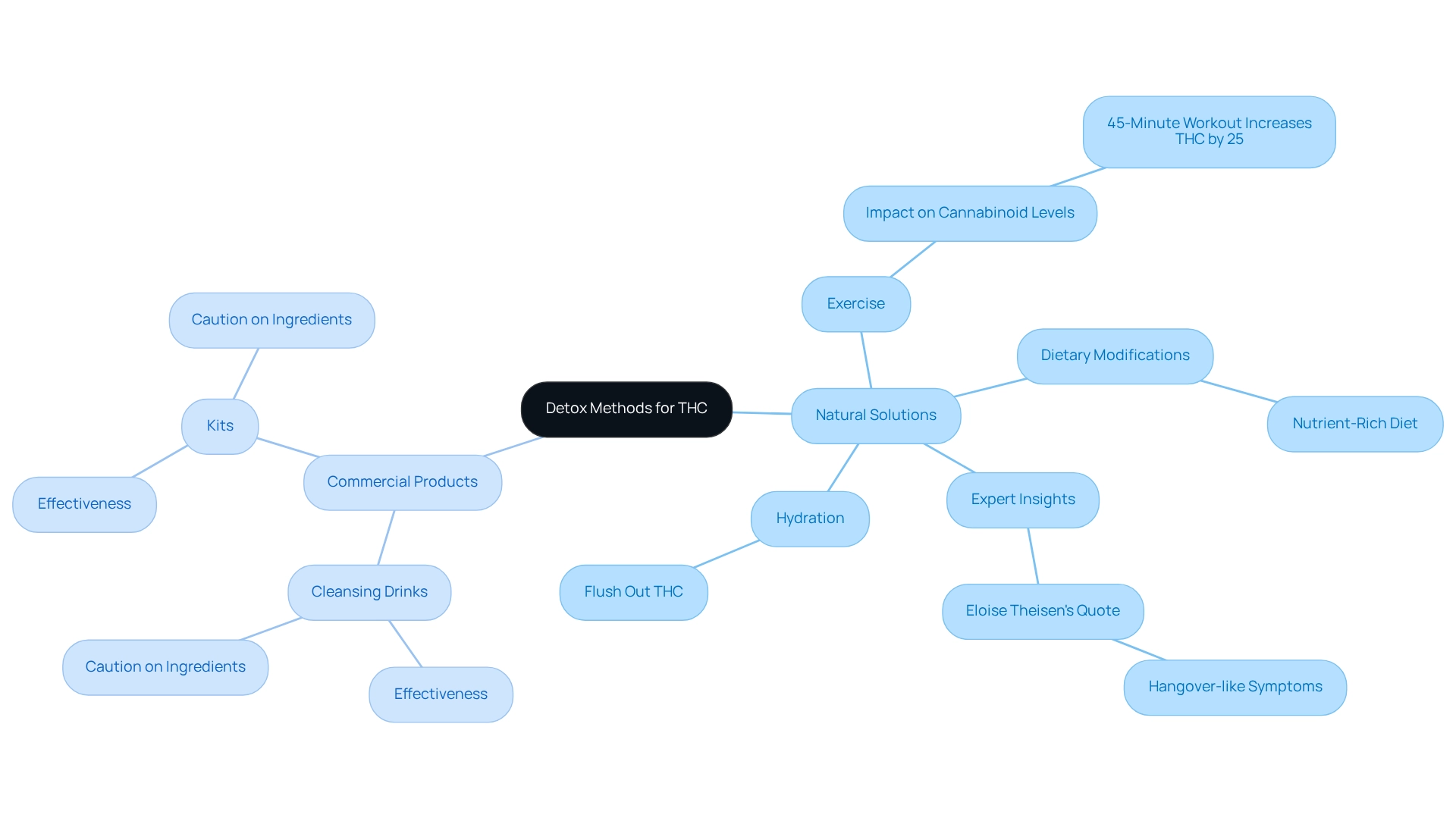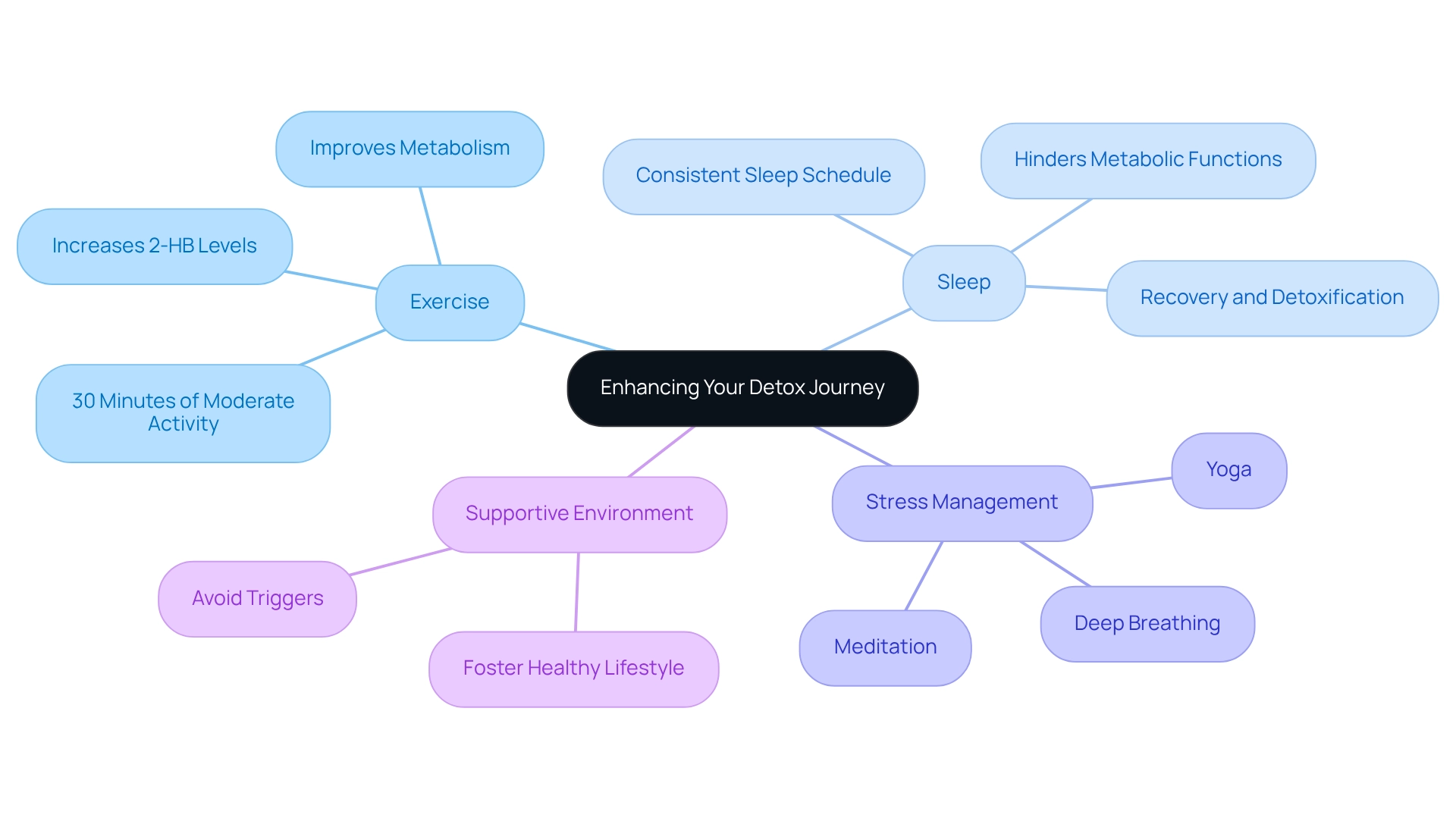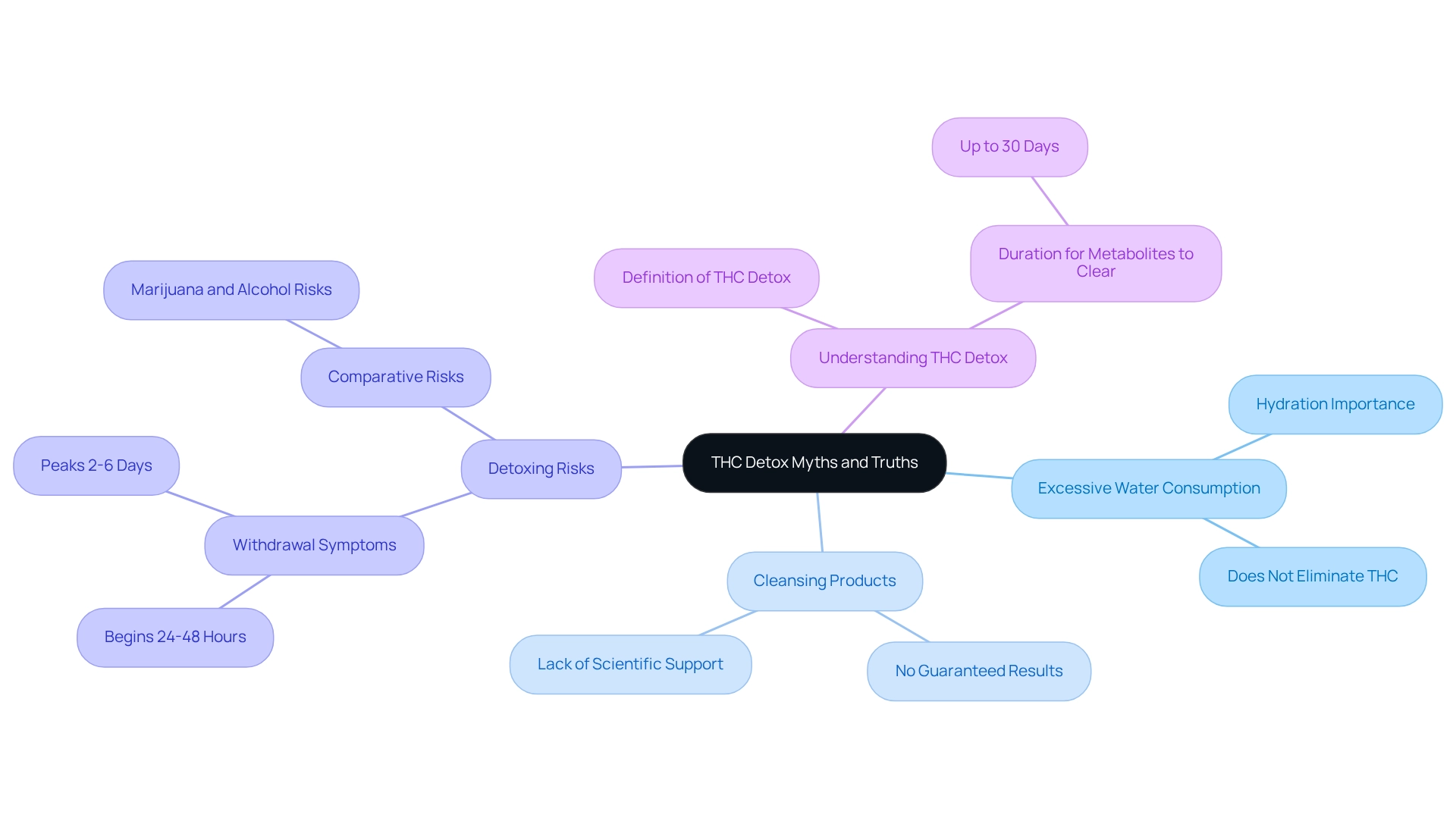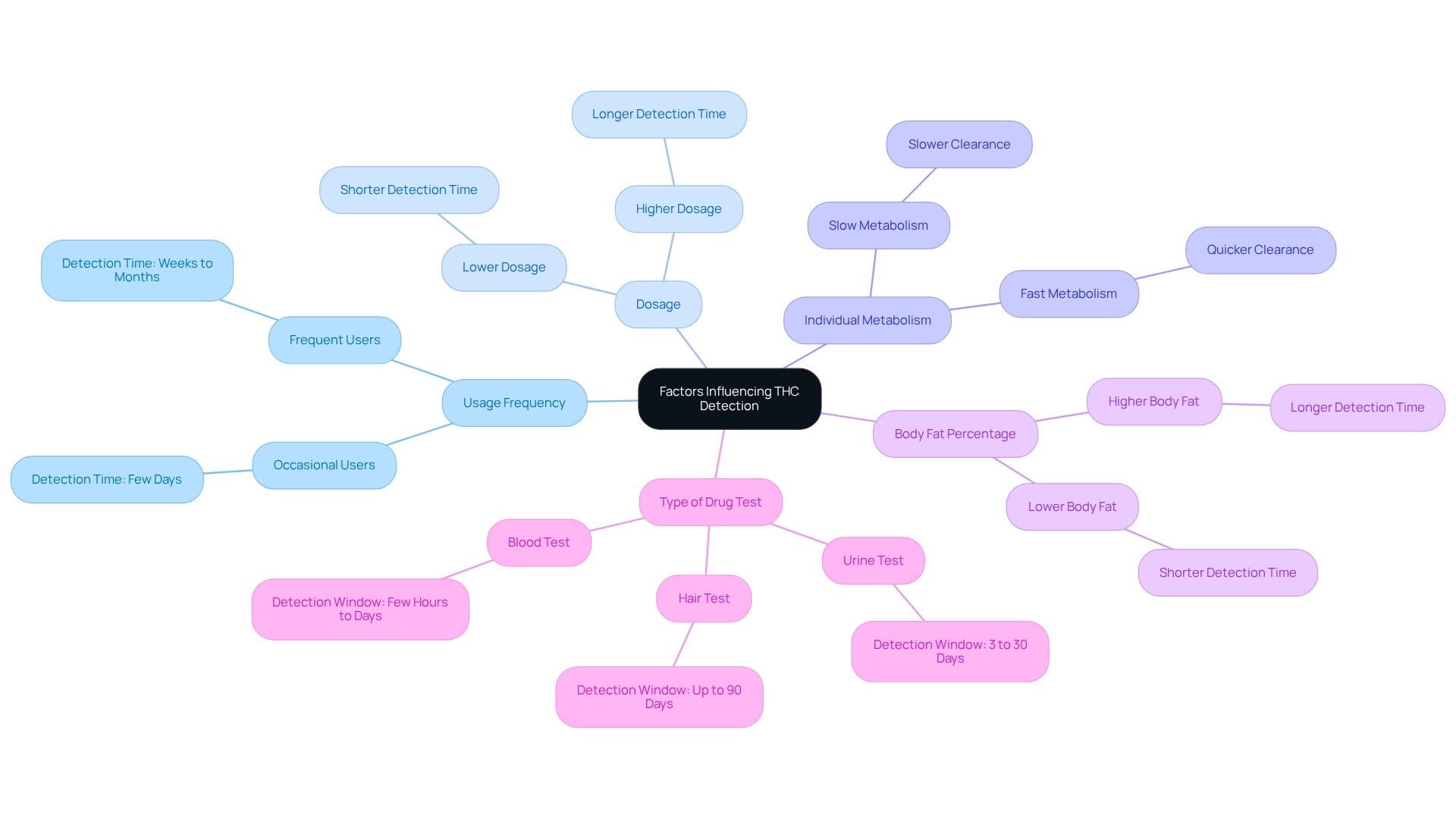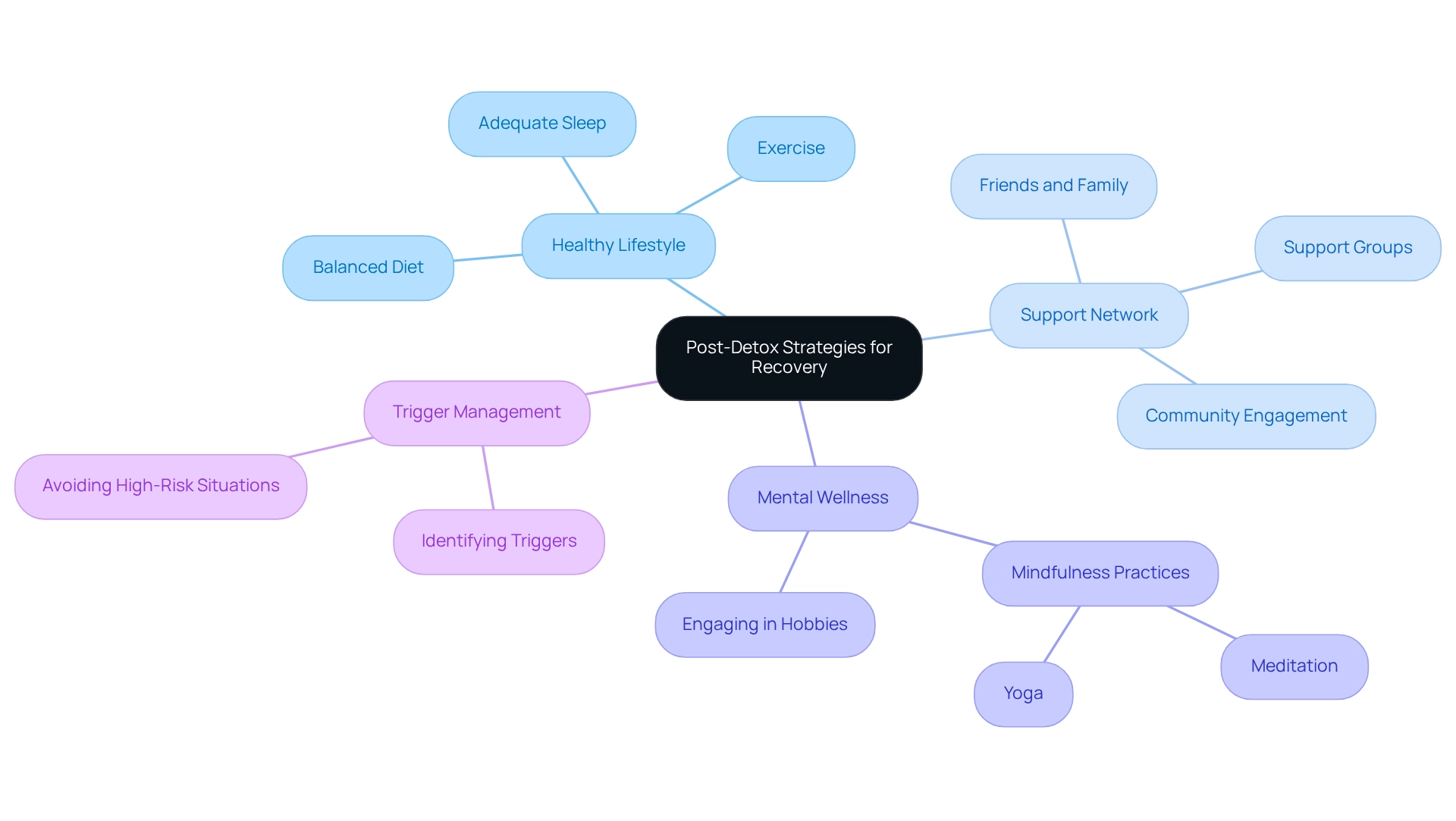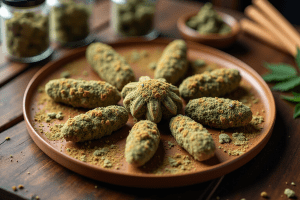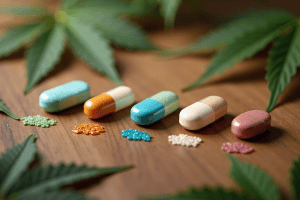Overview
This article gently explores the important question of how to effectively detox from THC. It outlines various strategies and methods that can support a successful detoxification journey. We understand that both natural approaches, such as:
- staying hydrated
- engaging in regular exercise
- maintaining a balanced diet
as well as commercial products, can play a role in this process. Importantly, it emphasizes the need to recognize individual circumstances and potential withdrawal symptoms, ensuring a comprehensive and compassionate approach to recovery.
Have you ever wondered what steps you can take to support your detox journey? By considering your unique situation, you can make informed choices that resonate with your needs. Remember, this journey is not just about the methods you choose, but also about nurturing your well-being throughout the process. Together, we can navigate this path towards recovery, making choices that feel right for you.
Introduction
In the intricate world of cannabis consumption, understanding the effects of tetrahydrocannabinol (THC) is crucial for both those who enjoy its recreational benefits and individuals seeking detoxification. While THC is often praised for its euphoric and relaxing qualities, it can also lead to anxiety and cognitive challenges. This dual nature prompts many to explore detox strategies.
This article aims to shed light on the complexities of THC, particularly regarding its impact on mental health and the vital role of detoxification in restoring clarity and well-being. Together, we will explore various methods—from natural and commercial detox options to dietary strategies and lifestyle changes—providing insights into effective ways to eliminate THC from our systems.
Have you ever wondered about the misconceptions surrounding detoxification? We will address these common myths, highlight when it might be necessary to seek professional help, and emphasize the importance of post-detox strategies to maintain your progress. As the legal landscape surrounding cannabis continues to change, making informed decisions is essential for navigating the challenges of THC consumption and detoxification. Together, let’s embark on this journey towards understanding and well-being.
Understanding THC: Effects and Implications for Detoxification
Tetrahydrocannabinol (THC) is the main psychoactive substance in marijuana, known for its ability to create feelings of euphoria, altered perception, and relaxation. However, it’s important to recognize that THC’s effects are not always positive; it can also lead to adverse reactions such as anxiety, paranoia, and impaired cognitive function. Understanding these dual effects is crucial for anyone considering THC detox. This process can help restore mental clarity and physical well-being.
Detoxification through THC detox is particularly important for individuals who experience negative side effects from THC or those looking to reset their tolerance levels. Are you preparing for a drug test or seeking to decrease your marijuana use? Recent studies indicate that THC can significantly impact mental health, with some users reporting increased anxiety and paranoia, especially at higher doses.
Indeed, the prevalence of THC-related anxiety is a growing concern among users, underscoring the need for effective THC detox methods. Case studies suggest that detoxification can lead to improved cognitive function and overall mental clarity. Many individuals who have undergone THC detox report enhanced focus and reduced anxiety levels after the process. Health professionals emphasize the importance of THC detox, noting that clearing THC from the system can alleviate cognitive impairments and promote better mental health outcomes.
As one health professional noted, ‘THC detox can significantly improve mental clarity and reduce anxiety, enabling individuals to regain control over their cognitive functions.’
While THC has its drawbacks, it is equally important to acknowledge its medical applications. Medical marijuana has been shown to decrease seizures in children with severe epilepsy by as much as 50%, offering hope to families in search of effective treatment alternatives. Furthermore, THC can alleviate symptoms of chronic pain and nausea associated with chemotherapy, highlighting its potential benefits in specific contexts.
Medical marijuana can serve as a safer option compared to conventional medications, which often come with harmful side effects. Some studies suggest that marijuana may also help alleviate sleep-related symptoms in PTSD and chronic pain patients, indicating that THC can have therapeutic effects alongside its risks.
As the legal landscape surrounding marijuana continues to evolve, with 18 states allowing recreational use and 36 states legalizing it for medical purposes, public opinion is increasingly supportive of marijuana use. This shift has led to a burgeoning legal marijuana market projected to reach a value of $50 billion by 2026. However, with this growth comes the responsibility of understanding the implications of THC consumption and the importance of THC detox for maintaining both mental clarity and physical well-being.
Notably, in 2012, 59% of federal inmates for marijuana-related charges were Hispanic, highlighting the social implications of marijuana use and its legal consequences. This context further emphasizes the need for informed decision-making regarding cannabis consumption. Together, we can navigate these complexities and make choices that promote our health and well-being.
Exploring Detox Methods: Natural vs. Commercial Solutions
Detoxification methods for THC detox can be divided into two primary categories: natural and commercial solutions. Natural cleansing techniques harness the body’s innate abilities to remove toxins, focusing on hydration, exercise, and dietary modifications. By drinking ample water, engaging in regular physical activity, and consuming a nutrient-rich diet filled with fruits and vegetables, we can significantly enhance our body’s ability to flush out THC.
It’s important to recognize that THC can be detectable in the body for days to weeks after marijuana use. This reality underscores the necessity of THC detox strategies, particularly for frequent users. For instance, individuals in a study reported using between 5 to 30 grams of hashish or similar marijuana weekly for over a month, highlighting the significance of these approaches.
On the other hand, commercial cleansing products, like cleansing drinks and kits, are often marketed as quick solutions for THC detox. While some users share positive experiences with these products, their effectiveness can vary widely. It’s crucial to approach these solutions with caution, as many factors influence their outcomes. Have you researched the ingredients and claims of these products? Informed decision-making is essential.
Additionally, it’s vital to acknowledge that around 75% of marijuana users seeking help for marijuana use disorder also have another substance use disorder. This statistic highlights the complexity of marijuana consumption and the need for effective THC detox methods.
Expert insights further illuminate the efficacy of natural cleansing methods. Eloise Theisen, a licensed nurse, emphasizes that while many people use cannabis for various reasons, some may experience hangover-like effects the following day. This reality reinforces the importance of effective THC detox strategies. Furthermore, case studies reveal that natural methods, such as exercise and fasting, can impact cannabinoid levels.
Interestingly, one study found that a 45-minute workout led to an average increase of 25% in serum THC levels. This indicates that while exercise may not directly cleanse the body, it can influence cannabinoid metabolism.
In summary, both natural and commercial cleansing methods come with their own advantages and drawbacks. As you consider your options, reflect on your individual circumstances and preferences. Together, let’s ensure that you are well-informed about the available cleansing strategies that can best support your journey.
Dietary Strategies for Effective THC Detox
A well-balanced diet is essential for effective THC detoxification. By prioritizing foods rich in fiber, antioxidants, and vital nutrients, we can enhance our body’s natural cleansing processes. Leafy greens like spinach and kale, along with berries, nuts, and whole grains, are excellent choices that support liver function and promote the elimination of toxins.
Research shows that a diet high in fiber significantly aids THC detox by facilitating the removal of THC metabolites from our bodies. Have you considered how hydration plays a vital role in this process? Aim to drink at least eight glasses of water daily to help flush out THC. Herbal teas, especially dandelion and green tea, are also beneficial due to their detoxifying properties. These drinks not only keep us hydrated but also provide extra antioxidants that support our cleansing journey.
It’s important to avoid processed foods, excessive sugars, and unhealthy fats, as these can hinder our detox efforts and negatively impact overall health. A case study on cleansing diets indicates that while they can encourage healthier eating habits, such as increased fruit and vegetable intake, they may also lead to negative effects like fatigue and nutrient deficiencies if overly restrictive. As Joanna Foley, RD, wisely notes, “While these diets do succeed in eliminating unhealthy and processed ‘junk foods’ and may induce short-term weight loss, they often deprive the body of vital nutrients necessary for proper detoxification and are not recommended by most Registered Dietitians or other health professionals.”
If you choose to pursue a cleansing diet, it should be short-term and inclusive of all food categories to ensure you receive the essential nutrients needed for effective detoxification.
Incorporating foods that support liver function, such as avocados, garlic, and beets, can further enhance your detox efforts. These foods are not only nutritious but also play a significant role in our body’s ability to process and eliminate toxins effectively. For instance, if you enjoy peanut butter, remember that increasing your serving size from two to four tablespoons means you should also multiply all nutritional values by two. This illustrates how serving sizes can impact our overall nutrient intake.
By focusing on a balanced diet and proper hydration, we can create a supportive environment for our bodies to undergo THC detox efficiently. It is also recommended to discuss any purification or cleanse methods with healthcare professionals to make informed decisions together.
Lifestyle Modifications to Enhance Your Detox Journey
Incorporating lifestyle modifications can significantly enhance your THC detox journey. Have you considered how consistent physical activity can be one of the most effective methods to boost your metabolism and assist in detoxifying your system? Aim for at least 30 minutes of moderate exercise on most days of the week. This not only aids in detoxification but also improves your overall well-being.
Research indicates that exercise can elevate levels of 2-hydroxybutyrate (2-HB), a metabolite crucial for energy metabolism, especially during detoxification phases. A study titled “Time-of-Day-Dependent Role of 2-HB in Systemic and Local Tissue Metabolism” emphasizes how exercise influences the production of 2-HB, highlighting its significance in metabolic processes during cleansing.
Prioritizing sleep is equally vital. Have you noticed how sufficient rest is essential for recovery and detoxification? Studies show that sleep deprivation can hinder metabolic functions, making it more challenging to eliminate toxins. Therefore, ensuring a consistent sleep schedule can significantly enhance your detox efforts.
As noted by fitness experts, “Quality sleep is crucial for optimal metabolic health and detoxification.”
In addition to exercise and sleep, managing stress through techniques such as meditation, yoga, or deep breathing exercises can further support your detoxification journey. Elevated cortisol levels, frequently linked to stress, can disrupt your body’s capacity to detoxify efficiently.
Moreover, creating a supportive environment by avoiding situations that may trigger cravings for marijuana is crucial. This holistic approach not only aids in detoxification but also fosters a healthier lifestyle overall, making your transition smoother and more sustainable. Together, let’s establish a balanced workout regimen during cleansing by setting achievable goals, combining various forms of exercise, remaining consistent, and paying attention to your physical state.
Debunking Myths: Common Misconceptions About THC Detox
Many myths surrounding THC detox can create confusion and lead to unrealistic expectations for those of us looking to purify ourselves of marijuana. One prevalent misconception is that drinking excessive amounts of water will quickly flush THC from our systems. While staying hydrated is important for our overall health, it does not effectively eliminate THC stored in fat cells.
Another common myth is the belief that cleansing products can guarantee a negative result on drug tests. Many of these products lack scientific support and may not work for everyone, leading to disappointment and frustration. In reality, there is no evidence that cleansing products can speed up the elimination of marijuana from our systems, which further emphasizes the need for practical expectations.
It’s also essential to understand that detoxing from THC does not carry the same risks as detoxing from more dangerous substances like opioids or alcohol. However, we may still experience withdrawal symptoms, which typically begin within 24 to 48 hours and peak between 2 to 6 days after we stop using. According to the Sonoma County Department of Health Services, “The risk associated with marijuana in combination with alcohol appears to be greater than that for either drug by itself,” highlighting the importance of understanding cannabis use in a broader context.
Defining THC detox, it is the process of stopping marijuana use to eliminate cannabinoids and terpenes from our bodies. It can take up to 30 days for metabolites to clear, underscoring the importance of understanding the cleansing process, including potential side effects and the factors that influence how long THC remains in our systems. By comprehending these myths and the truths about THC detox, we can approach our purification journey with informed and realistic expectations, ultimately fostering a healthier relationship with marijuana.
When to Seek Professional Help: Understanding the Need for Support
While many individuals can successfully cleanse from THC at home, those with a history of heavy use or facing severe withdrawal symptoms may benefit from professional assistance for THC detox. Are you experiencing intense cravings, anxiety, or depression? These feelings, along with physical symptoms that disrupt daily life, can be key indicators that you might need help. Research shows that approximately 47% of chronic marijuana users may experience withdrawal symptoms, which can manifest as irritability, insomnia, and decreased appetite.
According to a case study recognized by the DSM-5, these withdrawal symptoms can significantly impact daily functioning. Seeking assistance from a healthcare professional or addiction expert is essential, as they can provide customized resources and advice to navigate the withdrawal process safely. As Adrienne Webster, an Addiction Counselor Licensure Candidate, wisely states, “If you feel like your marijuana use has gotten out of control, it’s time to reach out for help.” Remember, professional help can significantly improve outcomes, especially considering that abstinence rates for adults in treatment range from 19 to 29 percent after one year.
Support groups and counseling also play a vital role in this journey, providing emotional support and effective strategies for managing cravings and triggers. Recognizing the signs of severe withdrawal during THC detox is crucial. If you find yourself struggling with debilitating symptoms, reaching out for help can be a pivotal step toward recovery. Chronic daily cannabis smokers can face significant withdrawal challenges, as detectable levels of THC and its metabolites may remain for up to one month after their last intake, underscoring the importance of a supportive detox process.
Real-world examples of support systems, such as community-based programs and online forums, can further assist individuals in their THC detox journey, fostering a sense of connection and understanding during this challenging time. Together, we can navigate this path toward healing and recovery.
Factors Influencing THC Detection: What You Need to Know
The duration THC remains detectable in the body is influenced by several key factors, including:
- Usage frequency
- Dosage
- Individual metabolism
- Body fat percentage
- The type of drug test employed
For instance, occasional users may remove THC from their system within a few days, while those who use marijuana regularly might need weeks or even months for full clearance.
Urine tests are the most prevalent method for THC detection, typically identifying usage within a window of 3 to 30 days, depending on the frequency of use. In contrast, hair tests can detect THC for up to 90 days, while blood tests generally have a shorter detection window, often only a few hours to a couple of days post-consumption.
Research indicates that only 61.9% of samples analyzed reported a consistent range of THC potency, highlighting the variability in individual responses to the substance and the implications for users. This variability is further intensified by factors such as metabolic rate and physical composition, which can significantly influence how quickly THC is processed and eliminated.
For instance, studies conducted by Yale’s Center for the Science of Cannabis and Cannabinoids aim to explore the metabolic pathways of THC and its impact on various demographics, including older adults and those with mental health disorders. These investigations are crucial for understanding the nuances of THC clearance and its implications for drug testing. As Pearlson noted, “People are not good judges of their driving impairment in terms of their safety to drive,” emphasizing the importance of understanding how THC affects impairment and the need for informed decision-making.
Have you ever wondered how your usage might affect detection times? Real-life examples illustrate that frequent users may experience detection times ranging from several weeks to months, while infrequent users often clear THC much more rapidly. By grasping these factors, we can better manage our expectations and prepare for any upcoming drug tests, ensuring we are informed about our own bodies, the effects of cannabis consumption, and the necessity of THC detox. Future studies will concentrate on assessing metabolite ratios at various time intervals and establishing the connection between increased ratios and impairment, which could further educate us about THC detection and cleansing strategies.
Post-Detox Strategies: Maintaining Your Progress and Avoiding Relapse
Successfully completing a THC detox marks the beginning of a journey towards long-term recovery. To sustain your progress and minimize the risk of relapse, it is essential to adopt effective strategies. Prioritizing a healthy lifestyle is crucial; this involves maintaining a balanced diet, engaging in regular exercise, and ensuring you get adequate sleep. These foundational elements not only support your physical health but also contribute to your mental well-being.
Establishing a strong support network is equally important. Surrounding yourself with friends, family, or joining support groups can provide the encouragement and accountability necessary for maintaining your commitment to sobriety. Have you considered how a supportive community could impact your recovery? Research indicates that individuals with robust support systems are less likely to relapse, emphasizing the critical role of community in recovery.
As noted, “Failure to continue a twelve-step program or attend addiction support group meetings could leave you vulnerable.”
Incorporating activities that promote mental wellness can also be beneficial. Mindfulness practices, such as meditation or yoga, along with engaging in hobbies, can help keep your mind occupied and reduce the likelihood of cravings. Identifying and avoiding triggers—situations or environments that may provoke a desire to use cannabis—is another key strategy. By proactively managing your lifestyle and surroundings, you can significantly diminish the chances of relapse.
Statistics show that relapse rates following cleansing can be concerning, with many individuals facing challenges in sustaining their progress. In fact, the 2022 National Survey on Drug Use and Health indicates that 22% of individuals aged 12 or older in the U.S. reported using marijuana in the past year, which translates to approximately 61.9 million people. This highlights the importance of effective THC detox strategies for a significant portion of the population.
However, by implementing these strategies and remaining vigilant, you can navigate the complexities of recovery more effectively. Real-world examples show that those who actively engage in their recovery process and utilize available resources are more likely to achieve lasting success. Remember, the journey does not end with detox; it is a continuous process of growth and self-discovery. Together, we can foster a supportive environment for healing and transformation.
Conclusion
Understanding the complexities of THC consumption and detoxification is essential for anyone looking to restore mental clarity and well-being. THC’s psychoactive properties can lead to both euphoric experiences and adverse effects, such as anxiety and cognitive impairments. Have you ever felt overwhelmed by these effects? As we navigate this together, it’s important to recognize that effective detox strategies—ranging from natural methods like hydration and exercise to dietary adjustments—play a crucial role in mitigating these negative impacts.
Moreover, addressing common misconceptions about detoxification can empower you to approach your detox journey with realistic expectations. Remember, seeking professional help is vital for those with a history of heavy use or severe withdrawal symptoms. Tailored support can significantly enhance recovery outcomes, guiding you towards a healthier path.
Ultimately, the journey towards detoxification and recovery is ongoing. Post-detox strategies, including maintaining a balanced lifestyle, establishing supportive networks, and practicing mindfulness, are vital for sustaining progress and preventing relapse. By embracing these practices, we can navigate the challenges of THC consumption more effectively and work towards achieving lasting clarity and well-being. The path to recovery is not just about eliminating THC from the body; it’s about fostering a healthier relationship with ourselves and cannabis in a rapidly evolving legal landscape.
Frequently Asked Questions
What is THC and what effects does it have?
Tetrahydrocannabinol (THC) is the main psychoactive substance in marijuana, known for creating feelings of euphoria, altered perception, and relaxation. However, it can also lead to adverse reactions such as anxiety, paranoia, and impaired cognitive function.
Why is THC detoxification important?
THC detoxification is important for individuals who experience negative side effects from THC or those looking to reset their tolerance levels. It can help restore mental clarity and physical well-being, alleviating cognitive impairments and promoting better mental health outcomes.
What are the reported benefits of THC detox?
Individuals who undergo THC detox often report improved cognitive function, enhanced focus, and reduced anxiety levels after the process. Health professionals note that clearing THC from the system can significantly improve mental clarity.
What are the methods for THC detox?
THC detox methods can be divided into natural and commercial solutions. Natural methods include hydration, exercise, and dietary modifications, while commercial products include cleansing drinks and kits marketed as quick solutions.
How can natural methods aid in THC detox?
Natural methods enhance the body’s ability to flush out THC through hydration, regular physical activity, and a nutrient-rich diet. Exercise can also influence cannabinoid metabolism, although it may not directly cleanse the body.
Are commercial detox products effective?
The effectiveness of commercial cleansing products can vary widely. While some users report positive experiences, it’s important to approach these solutions with caution and to research the ingredients and claims.
How long can THC be detectable in the body?
THC can be detectable in the body for days to weeks after marijuana use, which underscores the necessity of detox strategies, especially for frequent users.
What is the relationship between marijuana use disorder and other substance use disorders?
Approximately 75% of marijuana users seeking help for marijuana use disorder also have another substance use disorder, highlighting the complexity of marijuana consumption and the need for effective detox methods.
What medical applications does THC have?
THC has been shown to decrease seizures in children with severe epilepsy, alleviate chronic pain, and reduce nausea associated with chemotherapy. It may also help with sleep-related symptoms in PTSD and chronic pain patients.
How is public opinion and the legal landscape surrounding marijuana changing?
The legal landscape is evolving, with 18 states allowing recreational use and 36 states legalizing it for medical purposes. Public opinion is increasingly supportive of marijuana use, contributing to a growing legal marijuana market projected to reach $50 billion by 2026.
Get Your Medical Card
Connect with a licensed physician online in minutes


